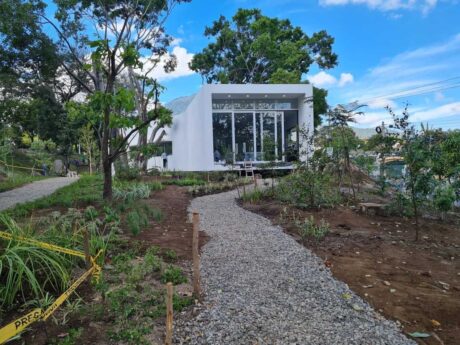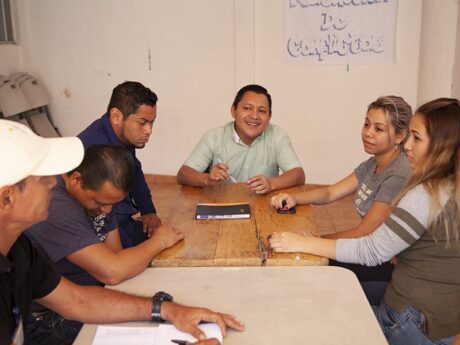In El Salvador, gang violence is a well-documented problem, notoriously pushing the homicide rate to one of the highest in the world. But Jeff Fischer, Creative Associates International’s Senior Electoral Advisor, warns that there is a lesser-known threat from gangs playing out in the country: electoral violence.
Fischer began research into gangs and electoral violence as part of an electoral security assessment in Haiti in 2015. He expanded his research into El Salvador in collaboration with the USAID Crime and Violence Prevention Project, implemented by Creative Associates International.
After conducting a two-week assessment in San Salvador in August 2017, followed by two additional study missions to the country, Fischer has written a report on electoral gang violence in El Salvador. Fischer and Jeffrey Carlson, Director of Creative’s Electoral Education and Integrity Practice Area, presented their research on gang-related electoral violence in El Salvador and Sierra Leone at the annual Gang Prevention and Intervention Conference in Los Angeles May 7-8.
Fischer says that gang-related electoral violence is a recent development in El Salvador. In 2012, he says, the relationship between political actors and gangs shifted: Gangs were introduced to the negotiation process as they worked with the government to reach a truce to reduce homicides.
After the truce was put into place, these groups began actively seeking to pressure government officials and politicians to bring them to the negotiating table.
From there, gangs – and the political actors and candidates themselves – began using violence to impact electoral outcomes.
In this Q&A, Fischer delves further into his findings.
What are some examples of ways gangs are organizing to use violence to affect elections?
Jeff Fischer: One reported gang electoral tactic is what can be termed a “controlled level” of homicides. With this tactic, gangs can reduce the number of murders in a given community to attribute a sense of security to the incumbent. Or they can increase the number of homicides in an opponent party’s community, creating a sense of insecurity among the population.
The efficacy of gangs’ ability to control the level of homicides is borne out by the experience of the truce, where, for a period of time, the national homicide rate dropped from 15 per day to five per day.
The following sequence of tactics has been observed, corresponding to phases of an election cycle:
During the pre-election phase, gangs have extorted payment, or “rentas,” from candidates and political parties to campaign in their territories safely. Also in the lead-up to an election, voter identity documents have been confiscated to prevent qualified electors from casting their ballots.
Then on Election Day, gangs have reportedly intimidated people to stay in their homes and disenfranchise themselves. Gangs are also said to threaten voters with violence if they see electoral ink on their fingers, showing that they cast their ballot that day. It has also been reported that gang members have been deployed as agents for candidates or political parties within polling stations to intimidate voters.
Are politicians and candidates complicit or actively involved in gang-related electoral violence?
Fischer: One observer noted that gangs do not typically contact politicians; instead, politicians contact gangs. Adversarial relationships between the two major parties and political polarization foster an environment for gang engagement, in that there is an embedded conflictive dimension to politics. During electoral processes and depending on the location, politicians may need the gangs more than gangs need the politicians.
Gangs provide access to territories and communities where, otherwise, political parties could not campaign. Gangs also mobilize voters within those communities and suppress voting for the opponent political forces. However, gangs have also agreed to vote at different times to avoid conflict at voting stations.
These activities present the dilemma of distinguishing between illicit activities and legitimate get-out-the-vote campaigns, especially when the Salvadoran government has estimated that 530,000 people, or 10.8 percent of the total population, are involved in gangs in some way.
How does this issue of electoral violence affect everyday people and the overall strength of democracy in El Salvador?
Fischer: Political polarization between parties will continue to foster a confrontational electoral environment laying the groundwork for the engagement of gangs for the purpose of political advantage.
It is anticipated that gangs will continue to attempt to augment their influence over the 2018 and 2019 election outcomes through the tactics which have emerged over the last couple of elections, including voter suppression, voter intimidation, controls on campaigning, delivering a voting bloc, and creating selective pockets of security and insecurity through controlled violence in support of some political actor.
While the government has prohibited direct negotiations with gangs, most believe that the political parties will continue “under the table” contacts because of the electoral benefits derived from such relationships in access to territories for campaigning and votes obtained and suppressed. As a result, enforcement of a “no negotiations” order could be elusive because of the deliberate opaqueness of such discussions.
Additionally, if gangs feel driven to employ violence in selected areas to create perceptions of security or insecurity, the question must be posed about whether such actions would compel negotiation in order to manage the violence overall. Gangs will be similarly motivated as in previous elections by financial incentives, relaxed enforcement of illicit activities and prison reforms.
How does the development community come into play on this issue?
Fischer: Armed with a voting bloc and voter suppression capabilities, gangs can employ violence and intimidation to achieve a political objective for a sponsoring party or candidate, while also making money. Given the closeness of many contests, the votes which gangs represent could be the difference between victory or defeat. If politicians desire to campaign in gang territories, the rentas payments — and even collusion — are perceived as the only way to do so without harassment. These factors compel relationships to be established.
However, it must be noted that this phenomenon has only matured to this degree since the 2012 truce and subsequent elections. While gangs have been around since the end of the civil war in the early 1990s, their engagement as political violence and electoral disruption actors has emerged over the last three or four years and, thus, is not deeply rooted in time.
Because of this recent emergence, no programming specifically directed at de-linking gangs and politicians has been pursued. Rather, relevant programming has focused on reducing the vulnerabilities for recruitment into gangs and desistance, with the long-term objective of reducing the supply. In this strategy, the objective is also to reduce the demand by politicians.



